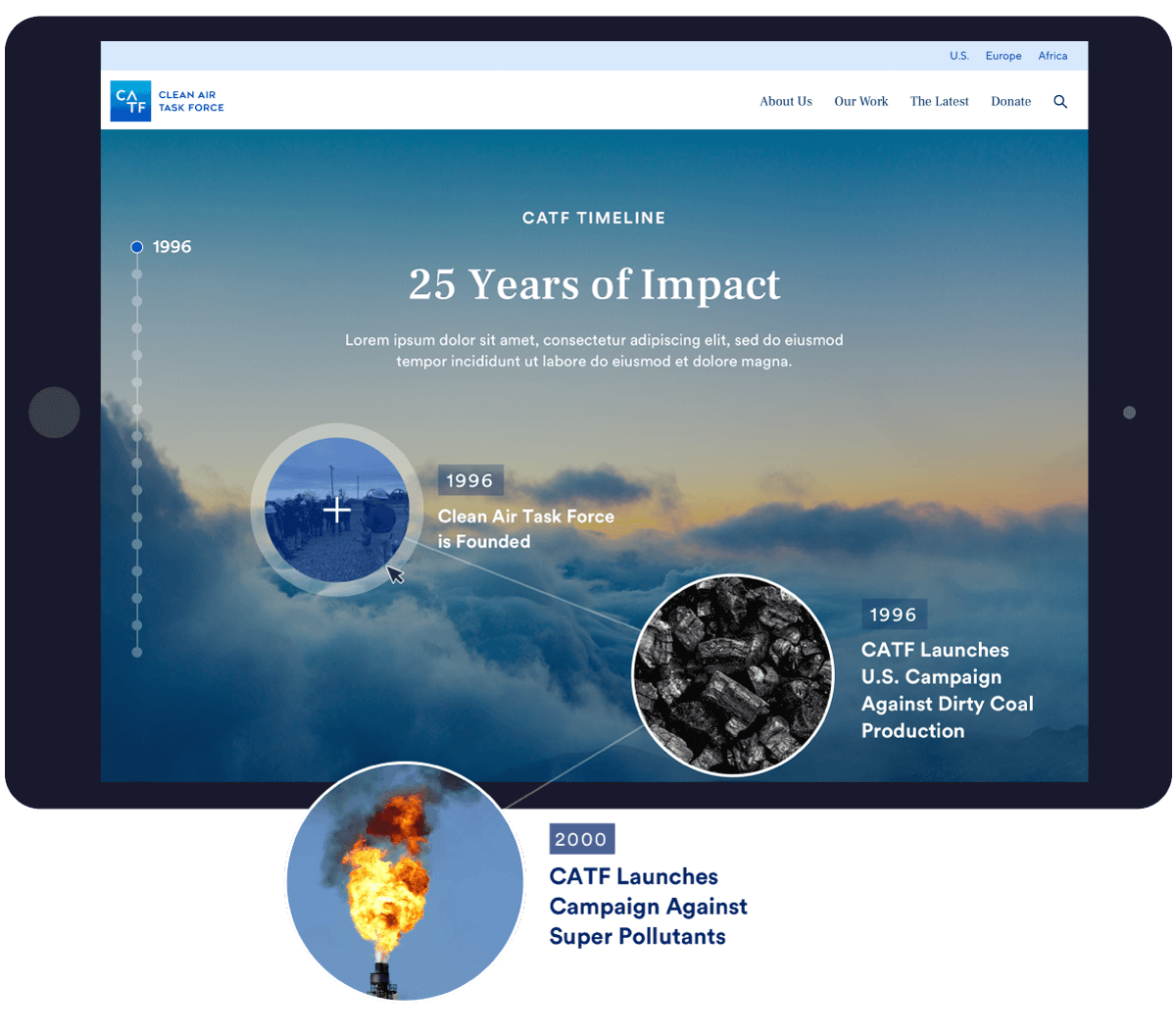About Us
We are a non-traditional, fact-based, environmental organization


Harmful emissions are causing our planet to undergo an unprecedented and rapid change.
At CATF, we build momentum for solutions based on scientific evidence, intellectual integrity, and pragmatism. We know that climate change is too complex a challenge and the stakes are too high for us to limit the tools at our disposal. We challenge conventional wisdoms and explore every opportunity that offers promise, and we’ve done so for more than 25 years.
Our Vision & Mission
Driving change forward through policy and innovation
Did you know that more than 70% of the emissions that cause global warming come from our energy system? Every year, the global energy system produces almost 40 billion tons of carbon dioxide emissions — pushing our planet toward irreversible climate tipping points. As emerging economies develop and their energy needs increase, that number will only increase unless we make dramatic changes to the way we power our world.
- Our Mission:
Push the technology and policy changes needed to achieve a zero-emissions, high-energy planet at an affordable cost. - Our Vision:
Meet the world’s rising energy demand in a way that is financially, socially, and environmentally sustainable.
Providing hope through bold, durable
climate solutions
In order to avoid the worst impacts of climate change, we must reduce global greenhouse gas emissions to net-zero by 2050, all while increasing energy access to billions of people living in energy poverty. It’s a massive challenge and the timeline is daunting, but there is hope. Clean Air Task Force is working to rapidly reduce emissions while advancing bold, durable climate solutions to ensure a net-zero emissions, high energy planet at an affordable cost.
Interactive timeline
Celebrating more than 25 years of impact
Over the past 25 years, CATF has carved out a unique role in the environmental and climate movement as a science-driven, solutions-focused, and strategic organization that gets results. Learn about how we got started and explore our history.

The Challenge
The time is now to ask hard questions
The planet is in serious danger and global climate policy is missing the mark.
Most climate action on energy has focused on three solution pathways: pricing carbon as a commodity, improving energy efficiency, and accelerating wind and solar electricity deployment. While these actions are useful, they address perhaps one-third of the climate change crisis. At CATF we’re asking, “What about the other two-thirds”?
In order to address the whole problem, we need carbon-free electricity available 24 hours a day, seven days a week, 365 days a year, and zero-carbon fuels to power a global energy system two times its current size. We know that in order to decarbonize the global energy system, we need to combine the best science and analysis with technology innovation and a policy landscape that accelerates progress at pace and scale.
Our Approach
Driving change forward
As an analysis- and results-driven organization, we are laser-focused on one thing: keeping carbon out of the atmosphere. This is an enormous challenge that requires innovation and change at every level. CATF’s operating approach is centered on change in four key areas:
- Change the narrative to communicate the size of the problem and totality of solution requirements.
- Change technology to make available the full suite of carbon-free options like advanced renewables, zero-carbon fuels, carbon capture, advanced nuclear, and superhot rock energy at an affordable cost.
- Change business models to include modular, manufacturable energy solutions that can be deployed anywhere quickly.
- Change policy to develop, demonstrate, and scale-up the technologies and systems needed to achieve net-zero emissions by midcentury.

We use these basic tools to achieve impact:
Research & Analysis
CATF, often in partnership with other leading experts, conducts extensive research into emission impacts, emission reduction opportunities, economic feasibility of energy technologies, and on potential decarbonization pathways in order to develop the fact-based, realistic strategies that drive our work. CATF’s in-depth approach to energy systems analysis and modeling plays an important role in changing the global conversation around how to decarbonize the global energy system.
Commercial Assessment & Support
Our global team of experts works to scope new and emerging low- and zero-emission energy technologies and evaluate their potential to scale to climate impact levels. We conduct extensive research and modelling to understand the factors that impact deployment, including cost, market ecosystem barriers, and business models. We work directly with low- and zero-emission energy companies on their business models and strategies and catalyze business-to-business partnerships and information sharing through workshops and site tours.
Policy & Technology Advocacy
Policy advocacy is an integral part of our organization, and a critical lever to combat climate change. CATF’s experts develop and advocate for policies that reduce and regulate emissions that are harmful to people and the planet. These policies allow governments to support research, development, and large scale deployment of zero-carbon energy through tax incentives or direct subsidies for early projects.
Legal Advocacy: Rulemaking, Litigation, & Legislation
CATF has a long history of legal and policy research, strategy, and technical record building which have resulted in many successful efforts to enact regulations and defend them from attempts to be weakened or repealed. As a key expert in this space, our legal team represents nonprofit clients in court cases, arguing in support of regulations that reduce pollution and protect the climate.
Education & Outreach
At CATF we view knowledge as a shared resource and seek to collaborate and expand our networks of influence with others by sharing what we know. We work to raise awareness of the health and climate impacts of pollution from power plants, oil and gas production, bioenergy, and other sources in order to empower others to make informed decisions and achieve impact. These efforts include making the case for and educating stakeholders on the need for a broad portfolio of scalable, low- and zero-emission energy solutions that can help us reach climate neutrality by midcentury.
Building Networks & Collaboration
CATF plays a catalytic role in developing ecosystems for collaboration, forming coalitions, and building campaigns that lead to crucial policy enactments and widespread public support.
Our Experts
We’re not just environmental advocates; We’re pragmatic problem solvers.
At CATF, we attract and retain some of the brightest talent in the world to explore, define, and envision new practical solutions that offer promise and accelerate change. CATF’s powerful team of scientists, engineers, MBAs, policy experts, lawyers, and communication experts are spread around the globe. We’re nimble, strategic, and virtual with a perpetual start-up mindset that allows us to stay ahead, disrupt, and lead.
Learn more about CATF
-

Our Board
CATF’s board is comprised of executive-level leaders with diverse backgrounds in energy, policy, law, advocacy, organizational management, and technology innovation.
-

Annual Report
From our start in 1996 to today, we’ve been expanding our pragmatic, science-based approach to match the global scale of the climate challenge.
-

Careers
Whether you’re an experienced professional, recent graduate, or passionate student, working with CATF could be a rewarding next step in your career.
Make an impact
Our independence from corporate influence and our willingness to resist popular thinking keeps us grounded in reality and focused on the changes that can truly make a difference. Support our work to safeguard against the worst impacts of climate change and become a donor today.



